St Saviour's Hospital
10 Osnaburgh Street, Regent's Park, NW1
Medical
dates:
Medical
character:
General
In 1845 Dr Edward Bouverie Pusey, one of the leaders of the Oxford Movement,
encouraged the founding of the Anglican Church's first sisterhood since
the Reformation of 1540. The convent of the Sisterhood of
the Holy Cross - or Park Village Community - opened on 26th March 1845
in a villa at No. 17 Park Village West to minister to the poor of St Pancras.
One of the nuns, Sister Clara, who had joined the order in 1847, donated the money with which to build a convent on a site in Osnaburgh Street, off Euston Road, facing the Holy Trinity Church.
Building work began in 1850 and was completed in two years.
Built in the Victorian Gothic style, it had three storeys and a basement. It was named St Saviour's and was the first building to be erected for an Anglican community since the Reformation.
The Sisterhood moved to the new premises in 1852 and Dame Palmer, the wife of Sir Henry Palmer, a friend of Dr Pusey, established a small hospital with 12 beds within the convent.
In 1856 the Sisterhood amalgamated with the Society of the Most Holy Trinity (the second Anglican Sisterhood to be established, in 1849 in Devonport - it was more commonly known as the Society of the Holy Trinity).
In 1872 the Hospital was renamed St Saviour's Cancer Hospital. Patients were not treated by surgery but by other means. A paste made from strong sulphuric acid mixed with finely powdered asbestos was applied to shrink the tumour, after which the affected parts were removed. (In 1875 it was claimed that 17 in-patients and 50 out-patients had been cured.) Treatments also included Matteism, a system based on electrohomeopathy invented by an Italian count, Cesare Mattei. (Dismissed by the medical profession as 'quackery', it nonetheless remained popular until the 1930s.) Indeed, by the end of the 1870s members of the medical profession had become alarmed at the Hospital's employment of medically unqualified staff and the cavalier way its practitioners had towards prescription of drugs without interviewing or examining the patient.
In 1886 the average weekly cost of an in-patient at the Hospital was £3 15s 0d (£3.75), a high sum for that period. In-patients were charged from 1 guinea (£1.05) to 2.5 gns (£2.63) a week.
A chapel was added to the building in the late 1880s. It was furnished with an elaborate altar-piece and other Baroque woodwork from the Carthusian monastery in Buxheim, Bavaria. Originally bought by Sir Henry Palmer to ornament one of the Colleges in Oxford, the carvings were resold and bought by Frederick Litchfield, Chairman of the Hospital, and fitted to the interior of St Saviour's chapel. (On the death of Mr Litchfield, the carvings were purchased from his Executors by the Hospital.)
The building of the chapel freed up space in the main building, enabling the Hospital to increase the number of beds. By 1891 it had 25 beds.
The basement of the building contained the kitchen, domestic offices and a small laundry. On the ground floor there was a large cheerful Nurses' Refectory, two sitting rooms for the Sisters, a Committee Room and a dispensary. The first floor contained one ward with 7 beds, two wards with 1 bed each and one 2-bedded ward (in which operations were performed), 3 bathrooms, 3 WCs, the Sister's bedrooms, the (female) dispenser's bedroom and an emergency ward with 2 beds. On the second floor were a ward with 13 beds and a 1-bedded ward, also a bathroom and a WC, and a row of cubicles for the nurses, each with its own window. Patients' clothes were kept in a basket under their beds. The Hospital was lit by gaslight. At the back there was a pleasant little garden (the mortuary was beyond the garden).
In 1892 the Hospital was renamed St Saviour's Hospital for Invalid Ladies - for the medical and surgical treatment of 'ladies of limited means', that is, they could afford to pay a little, but found it impossible to meet the usual charges of nursing homes.
In 1893 the lease of the building was assigned to the Revd. Arthur Brinckman who, with the Sisters of the All Saints' Community and a Committee, took over the running of the Hospital. It was renamed St Saviour's Hospital for Ladies of Limited Means. A ward for sick nurses was opened.
The clinicians gave their services free. Patients of any religion were accepted. The weekly charge varied from 12 shillings and 6 pence (63p) to 3 guineas (£3.15) - most patients paid the minimum. The honorary medical staff consisted of 3 physicians, 3 surgeons, an obstetrician, an ophthalmologist, a dental surgeon and an emergency officer. The nursing staff comprised a Sister-in-charge, a Housekeeping Sister and 7 nurses (and an 8th when required).
In 1905 some 137 women were treated throughout the year, providing an income of £88 6s (£88.30), although the total expenditure of the Hospital exceeded £2,000. No patient was admitted without a certificate from her medical attendant, and a testimonial as to her fitness from a financial point of view.
In 1914 the Hospital had 25 beds, with an average daily occupation of 15.
In 1921 a new boiler was installed at a cost of £400.
On 1st August 1925 the Hospital had to close until 1st March 1926, as the whole drainage system had been condemned and needed to be reconstructed. While this was being carried out, a large chimney stack was found to be giving, and this also had to be rebuilt. In addition, an outside staircase was added as a fire escape. The work cost £4,000.
By 1929 the Hospital was known simply as St Saviour's Hospital. Chronic invalids, infectious or contagious cases, epileptics, maternity, ear nose and throat cases, and mentally ill patients were not eligible for admission.
In 1932 it had 21 beds, with an average daily occupation of 15 throughout the year. Patients paid 2 - 5 gns (£2.10 - £5.25) a week, and stayed on average for 29 days. There were two wards and 3 private patient rooms. A bed in the 6-bedded ward cost 3 gns (£3.15) a week. The other ward had 12 beds, 6 of which were curtained off into cubicles (these cost 3 gns a week). The 6 beds without curtains cost 2 gns (£2.10) a week. The private patient rooms were 4 - 5 gns (£4.20 - £5.25) a week. No medical fees were allowed. There was a library and, of course, the chapel with its beautifully carved woodwork, and a garden for open air exercise.
However, the average weekly cost to the Hospital for an in-patient in 1932 was £5 5s 9d (£5.29), compared to £5 13s 11d (£5.70) in 1931.
Between 1892 and 1932 some 5,718 patients had been admitted. Of these, 3,354 had been discharged cured, 1,566 improved, 269 not improved, 165 discharged for a special reason (not specified) and 141 had died.
On 6th August 1932 the Hospital closed for repairs and cleaning, and for holidays for the staff. It reopened a month later, on 5th September.
In 1935 the Community of the Presentation took over the nursing care at the Hospital from the All Saint's Community.
The Community of the Presentation, a nursing order, had been founded in 1927 from members of the Community of the Epiphany in Truro and had been previously known as the Nursing Community of Christ the Consoler. The Sisters lived in a convent at St George's House in Highgate, which also contained a nursing home. The Community also had a convalescent home in Hythe, Kent.
In 1939, at the onset of WW2, the Hospital joined the Emergency Medical Service with 21 beds.
From 1945 until 1948 12 beds had to be closed due to the lack of nursing and domestic staff. More patients were acute surgical cases.
In 1948 the Hospital was disclaimed from the NHS and remained an independent charitable concern. The nursing staff consisted of a Mother Superior and 10 nurses (5 Sisters and 5 lay nurses), a cook and 3 domestics. The top floor contained 10 beds, but a lift was needed to make this ward more accessible, as medical patients were required to attend Harley Street to be X-rayed, while cancer patients had to attend the Radiotherapy Department at the Middlesex Hospital for treatment. A lift was finally installed in 1950.
In 1952 the Hospital Committee considered plans for expansion by buying the factory next door, but delayed acting because of the future possibility of a road widening scheme.
At the end of the 1950s the operating theatre was renovated and the large top floor ward was converted into 6 private patient rooms, at a cost of £13,000.
In 1955 the Hospital had 19 beds (according to Matron - the Chairman claimed 21), with a bed occupancy of 68%. There were 11 Sisters (unpaid) and 3 night nurses (who were paid). The weekly charge for a medical bed was 5 gns (£5.25) and, for a surgical bed, 4 gns (£4.20) plus 2 gns (£2.10) operating fee.
In 1957 a Visiting Committee from the King's Fund examined the premises. They found the Hospital dingy and gloomy; it gave the impression of many small rooms connected by tortuous passages. The weekly charge was 3 - 4 gns (£3.15 - £4.20) for a bed in an open ward, and 7 gns (£7.35) for a private room. Most patients belonged to B.U.P.A. or the L.A.H.S. The nursing staff, mainly nuns, were qualified State Registered Nurses.
In 1958 the Hospital had 24 beds, with an average bed occupancy of 13. By 1959 it had 22 beds, of which 19 were open, with an average bed occupancy of 11.
In 1959 the Hospital closed for 6 weeks in the summer as a holiday for the Sisters, who were not paid.
In 1960 the building was subject to a compulsory purchasing order from the LCC, which was planning a road widening scheme.
The Hospital closed in 1962.
One of the nuns, Sister Clara, who had joined the order in 1847, donated the money with which to build a convent on a site in Osnaburgh Street, off Euston Road, facing the Holy Trinity Church.
Building work began in 1850 and was completed in two years.
Built in the Victorian Gothic style, it had three storeys and a basement. It was named St Saviour's and was the first building to be erected for an Anglican community since the Reformation.
The Sisterhood moved to the new premises in 1852 and Dame Palmer, the wife of Sir Henry Palmer, a friend of Dr Pusey, established a small hospital with 12 beds within the convent.
In 1856 the Sisterhood amalgamated with the Society of the Most Holy Trinity (the second Anglican Sisterhood to be established, in 1849 in Devonport - it was more commonly known as the Society of the Holy Trinity).
In 1872 the Hospital was renamed St Saviour's Cancer Hospital. Patients were not treated by surgery but by other means. A paste made from strong sulphuric acid mixed with finely powdered asbestos was applied to shrink the tumour, after which the affected parts were removed. (In 1875 it was claimed that 17 in-patients and 50 out-patients had been cured.) Treatments also included Matteism, a system based on electrohomeopathy invented by an Italian count, Cesare Mattei. (Dismissed by the medical profession as 'quackery', it nonetheless remained popular until the 1930s.) Indeed, by the end of the 1870s members of the medical profession had become alarmed at the Hospital's employment of medically unqualified staff and the cavalier way its practitioners had towards prescription of drugs without interviewing or examining the patient.
In 1886 the average weekly cost of an in-patient at the Hospital was £3 15s 0d (£3.75), a high sum for that period. In-patients were charged from 1 guinea (£1.05) to 2.5 gns (£2.63) a week.
A chapel was added to the building in the late 1880s. It was furnished with an elaborate altar-piece and other Baroque woodwork from the Carthusian monastery in Buxheim, Bavaria. Originally bought by Sir Henry Palmer to ornament one of the Colleges in Oxford, the carvings were resold and bought by Frederick Litchfield, Chairman of the Hospital, and fitted to the interior of St Saviour's chapel. (On the death of Mr Litchfield, the carvings were purchased from his Executors by the Hospital.)
The building of the chapel freed up space in the main building, enabling the Hospital to increase the number of beds. By 1891 it had 25 beds.
The basement of the building contained the kitchen, domestic offices and a small laundry. On the ground floor there was a large cheerful Nurses' Refectory, two sitting rooms for the Sisters, a Committee Room and a dispensary. The first floor contained one ward with 7 beds, two wards with 1 bed each and one 2-bedded ward (in which operations were performed), 3 bathrooms, 3 WCs, the Sister's bedrooms, the (female) dispenser's bedroom and an emergency ward with 2 beds. On the second floor were a ward with 13 beds and a 1-bedded ward, also a bathroom and a WC, and a row of cubicles for the nurses, each with its own window. Patients' clothes were kept in a basket under their beds. The Hospital was lit by gaslight. At the back there was a pleasant little garden (the mortuary was beyond the garden).
In 1892 the Hospital was renamed St Saviour's Hospital for Invalid Ladies - for the medical and surgical treatment of 'ladies of limited means', that is, they could afford to pay a little, but found it impossible to meet the usual charges of nursing homes.
In 1893 the lease of the building was assigned to the Revd. Arthur Brinckman who, with the Sisters of the All Saints' Community and a Committee, took over the running of the Hospital. It was renamed St Saviour's Hospital for Ladies of Limited Means. A ward for sick nurses was opened.
The clinicians gave their services free. Patients of any religion were accepted. The weekly charge varied from 12 shillings and 6 pence (63p) to 3 guineas (£3.15) - most patients paid the minimum. The honorary medical staff consisted of 3 physicians, 3 surgeons, an obstetrician, an ophthalmologist, a dental surgeon and an emergency officer. The nursing staff comprised a Sister-in-charge, a Housekeeping Sister and 7 nurses (and an 8th when required).
In 1905 some 137 women were treated throughout the year, providing an income of £88 6s (£88.30), although the total expenditure of the Hospital exceeded £2,000. No patient was admitted without a certificate from her medical attendant, and a testimonial as to her fitness from a financial point of view.
In 1914 the Hospital had 25 beds, with an average daily occupation of 15.
In 1921 a new boiler was installed at a cost of £400.
On 1st August 1925 the Hospital had to close until 1st March 1926, as the whole drainage system had been condemned and needed to be reconstructed. While this was being carried out, a large chimney stack was found to be giving, and this also had to be rebuilt. In addition, an outside staircase was added as a fire escape. The work cost £4,000.
By 1929 the Hospital was known simply as St Saviour's Hospital. Chronic invalids, infectious or contagious cases, epileptics, maternity, ear nose and throat cases, and mentally ill patients were not eligible for admission.
In 1932 it had 21 beds, with an average daily occupation of 15 throughout the year. Patients paid 2 - 5 gns (£2.10 - £5.25) a week, and stayed on average for 29 days. There were two wards and 3 private patient rooms. A bed in the 6-bedded ward cost 3 gns (£3.15) a week. The other ward had 12 beds, 6 of which were curtained off into cubicles (these cost 3 gns a week). The 6 beds without curtains cost 2 gns (£2.10) a week. The private patient rooms were 4 - 5 gns (£4.20 - £5.25) a week. No medical fees were allowed. There was a library and, of course, the chapel with its beautifully carved woodwork, and a garden for open air exercise.
However, the average weekly cost to the Hospital for an in-patient in 1932 was £5 5s 9d (£5.29), compared to £5 13s 11d (£5.70) in 1931.
Between 1892 and 1932 some 5,718 patients had been admitted. Of these, 3,354 had been discharged cured, 1,566 improved, 269 not improved, 165 discharged for a special reason (not specified) and 141 had died.
On 6th August 1932 the Hospital closed for repairs and cleaning, and for holidays for the staff. It reopened a month later, on 5th September.
In 1935 the Community of the Presentation took over the nursing care at the Hospital from the All Saint's Community.
The Community of the Presentation, a nursing order, had been founded in 1927 from members of the Community of the Epiphany in Truro and had been previously known as the Nursing Community of Christ the Consoler. The Sisters lived in a convent at St George's House in Highgate, which also contained a nursing home. The Community also had a convalescent home in Hythe, Kent.
In 1939, at the onset of WW2, the Hospital joined the Emergency Medical Service with 21 beds.
From 1945 until 1948 12 beds had to be closed due to the lack of nursing and domestic staff. More patients were acute surgical cases.
In 1948 the Hospital was disclaimed from the NHS and remained an independent charitable concern. The nursing staff consisted of a Mother Superior and 10 nurses (5 Sisters and 5 lay nurses), a cook and 3 domestics. The top floor contained 10 beds, but a lift was needed to make this ward more accessible, as medical patients were required to attend Harley Street to be X-rayed, while cancer patients had to attend the Radiotherapy Department at the Middlesex Hospital for treatment. A lift was finally installed in 1950.
In 1952 the Hospital Committee considered plans for expansion by buying the factory next door, but delayed acting because of the future possibility of a road widening scheme.
At the end of the 1950s the operating theatre was renovated and the large top floor ward was converted into 6 private patient rooms, at a cost of £13,000.
In 1955 the Hospital had 19 beds (according to Matron - the Chairman claimed 21), with a bed occupancy of 68%. There were 11 Sisters (unpaid) and 3 night nurses (who were paid). The weekly charge for a medical bed was 5 gns (£5.25) and, for a surgical bed, 4 gns (£4.20) plus 2 gns (£2.10) operating fee.
In 1957 a Visiting Committee from the King's Fund examined the premises. They found the Hospital dingy and gloomy; it gave the impression of many small rooms connected by tortuous passages. The weekly charge was 3 - 4 gns (£3.15 - £4.20) for a bed in an open ward, and 7 gns (£7.35) for a private room. Most patients belonged to B.U.P.A. or the L.A.H.S. The nursing staff, mainly nuns, were qualified State Registered Nurses.
In 1958 the Hospital had 24 beds, with an average bed occupancy of 13. By 1959 it had 22 beds, of which 19 were open, with an average bed occupancy of 11.
In 1959 the Hospital closed for 6 weeks in the summer as a holiday for the Sisters, who were not paid.
In 1960 the building was subject to a compulsory purchasing order from the LCC, which was planning a road widening scheme.
The Hospital closed in 1962.
Present status (February 2009)
The Sisters of the Presentation relocated to their existing convalescent home in Seabrook Road, Hythe, in Kent and built a new St Saviour's Hospital there, with 13 beds. The 17th century Buxheim carvings were transferrred from Osnaburgh Street to the new chapel in Hythe.
The Osnaburgh Street premises were demolished in 1963 to make way for the widening of Euston Road.
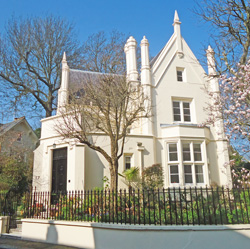
No. 17 Park Village West was the first site of the convent of the Sisterhood of the Holy Cross. (Photograph obtained in March 2016).
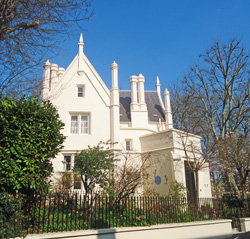
A plaque on the left hand side of the porch (above and below) commemorates the Community. (Photograph obtained in March 2016).
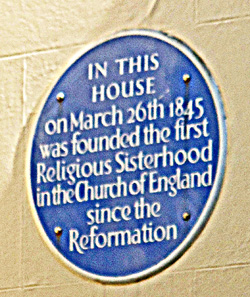
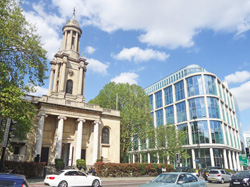
The site of St Saviour's Hospital, opposite the former Holy Trinity Church (shown in the left of the image), is now part of Regent's Place, a 13-acre office, retail and residential development.

The site of the Hospital across from the Holy Trinity Church (above) and looking along Osnaburgh Street towards Euston Road (below).
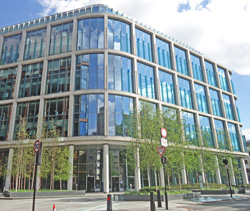
(Author unstated) 1875 The cure of cancer. South Australian Register, 5th August, 5.
(Author unstated) 1879 St Saviour's Cancer Hospital. British Medical Journal 2 (973), 315.
(Author unstated) 1889 Hospital reports of 1886. British Medical Journal 1 (1466), 274.
(Author unstated) 1891 (Untitled). British Medical Journal 1 (1588), 1252.
(Author unstated) 1905 St Saviour's Hospital for Ladies of Limited Means. British Medical Journal 2 (2330), 468.
Black N 200X Walking
Mumm, Susan ed. (2001). All Saints Sisters of the Poor: an Anglican sisterhood in the Nineteenth Century. Woodbridge, Boydell.
Williams TJ 1945 The Revival of the Religious Life. The Living Church 110 (8), 13.
Wood CJ 1893 Ward for sick nurses. British Medical Journal 1 (1693), 1252.
https://en.wikipedia.org (1)
https://en.wikipedia.org (2)
https://en.wikipedia.org (3)
http://randomnecessareality.blogspot.co.uk
http://wellcomelibrary.org (1)
http://wellcomelibrary.org (2)
www.ahbs.org.uk
www.british-history.ac.uk (1)
www.british-history.ac.uk (2)
www.british-history.ac.uk (3)
www.flickr.com (1)
www.flickr.com (2)
www.flickr.com (3)
www.flickriver.com
www.franciscanarchive.org.uk
www.hamhigh.co.uk
www.lookandlearn.com
Return to home page